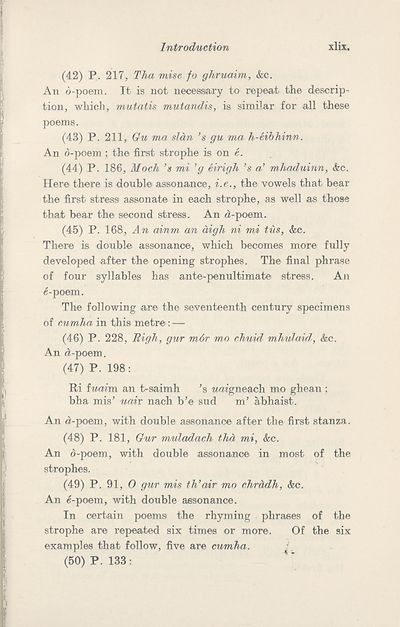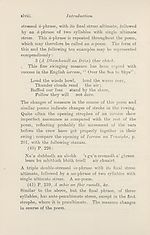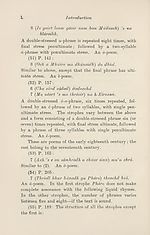Download files
Complete book:
Individual page:
Thumbnail gallery: Grid view | List view

Introduction
xlix.
(42) P. 217, Tha mise fo ghruaim, &c.
An 6-poem. It is not necessary to repeat the descrip¬
tion, which, mutatis mutandis, is similar for all these
poems.
(43) P. 211, Gu ma sldn’s gu ma h-eibhinn.
An 6-poem; the first strophe is on e.
(44) P. 186, Moch ’s mi ’g eirigh ’s a' mhaduinn, &c.
Here there is double assonance, i.e., the vowels that bear
the first stress assonate in each strophe, as well as those
that bear the second stress. An 6-poem.
(45) P. 168, An ainm an digit ni mi tus, &c.
There is double assonance, which becomes more fully
developed after the opening strophes. The final phrase
of four syllables has ante-penultimate stress. An
c-poem.
The following are the seventeenth century specimens
of cumha in this metre: —
(46) P. 228, Righ, gur m6r mo chuid mhulaid, &c.
An 6-poem.
(47) P. 198:
Ri iuaim an t-saimh ’s waigneach mo ghean;
bha mis’ uair nach b’e sud m’ abhaist.
An 6-poem, with double assonance after the first stanza.
(48) P. 181, Gur muladach thd mi, <fec.
An 6-poem, with double assonance in most of the
strophes.
(49) P. 91, 0 gur mis th’air mo chrddh, &c.
An e-poem, with double assonance.
In certain poems the rhyming phrases of the
strophe are repeated six times or more. Of the six
examples that follow, five are cumha.
(50) P. 133:
xlix.
(42) P. 217, Tha mise fo ghruaim, &c.
An 6-poem. It is not necessary to repeat the descrip¬
tion, which, mutatis mutandis, is similar for all these
poems.
(43) P. 211, Gu ma sldn’s gu ma h-eibhinn.
An 6-poem; the first strophe is on e.
(44) P. 186, Moch ’s mi ’g eirigh ’s a' mhaduinn, &c.
Here there is double assonance, i.e., the vowels that bear
the first stress assonate in each strophe, as well as those
that bear the second stress. An 6-poem.
(45) P. 168, An ainm an digit ni mi tus, &c.
There is double assonance, which becomes more fully
developed after the opening strophes. The final phrase
of four syllables has ante-penultimate stress. An
c-poem.
The following are the seventeenth century specimens
of cumha in this metre: —
(46) P. 228, Righ, gur m6r mo chuid mhulaid, &c.
An 6-poem.
(47) P. 198:
Ri iuaim an t-saimh ’s waigneach mo ghean;
bha mis’ uair nach b’e sud m’ abhaist.
An 6-poem, with double assonance after the first stanza.
(48) P. 181, Gur muladach thd mi, <fec.
An 6-poem, with double assonance in most of the
strophes.
(49) P. 91, 0 gur mis th’air mo chrddh, &c.
An e-poem, with double assonance.
In certain poems the rhyming phrases of the
strophe are repeated six times or more. Of the six
examples that follow, five are cumha.
(50) P. 133:
Set display mode to:
![]() Universal Viewer |
Universal Viewer | ![]() Mirador |
Large image | Transcription
Mirador |
Large image | Transcription
| An Comunn Gàidhealach > An Comunn Gàidhealach Publications > Bàrdachd Ghàidhlig > (53) |
|---|
| Permanent URL | https://digital.nls.uk/126455654 |
|---|
| Description | This contains items published by An Comunn, which are not specifically Mòd-related. It includes journals, annual reports and corporate documents, policy statements, educational resources and published plays and literature. It is arranged alphabetically by title. |
|---|
| Description | A collection of over 400 items published by An Comunn Gàidhealach, the organisation which promotes Gaelic language and culture and organises the Royal National Mòd. Dating from 1891 up to the present day, the collection includes journals and newspapers, annual reports, educational materials, national Mòd programmes, published Mòd literature and music. |
|---|---|
| Additional NLS resources: |
|

